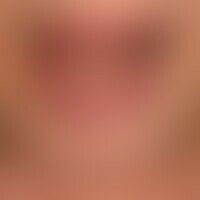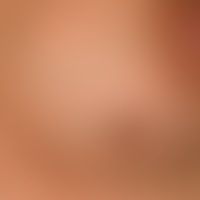Image diagnoses for "Plaque (raised surface > 1cm)"
586 results with 2919 images
Results forPlaque (raised surface > 1cm)

Psoriasis palmaris et plantaris (overview) L40.3
Psoriasis palmaris et plantaris: dry keratotic plaque type. Pretreated psoriasis plantaris: typical pattern of infection with flat, sharply defined red plaques with and without scaly deposits.

Pseudoxanthoma elasticum Q82.8
Pseudoxanthoma elasticum. net and striped, slightly raised, yellowish papules with stretched neck.

Hair tongue black K14.3

Circumscribed scleroderma L94.0
scleroderma circumscripts (linear type): band-shaped expression of the scleroderma focus on the upper and lower leg. in the thigh area, clear atrophy of skin, subcutaneous fatty tissue (and muscles). clinical picture developed over a period of about 7 years. pulling and stabbing complaints during sports activities.

Naevus melanocytic common D22.-
Nevus melanocytic more common: dermal n evoid melanocytes with monomorphic nucleus and only a few single nucleoli in here neuroid cytomorphological features with a wider pale eosinophilic cytoplasmic border
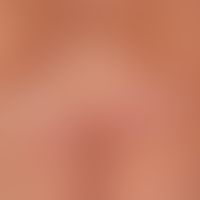
Lichen sclerosus (overview) L90.4
Lichen sclerosus et atrophicus. extensive extragenital 'infestation with typical "leathery" changes of the skin surface due to a distinct orthohyperkeratosis in the fallen areas. the areas are brightly discolored due to orhtohyperkeratosis and the underlying "edema zone". thus the natural color of the area is lost.
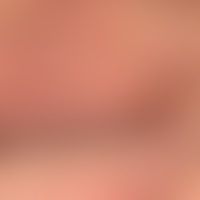
Eyelid dermatitis (overview) H01.11
Chronic seborrhoeic eyelid dermatitis: chronic blurred scaly plaques, increased desquamation with scaly retentions in the eyelid area.

Favus B35.0
Favus. solitary, acute, approx. 3.0 x 2.5 cm, acutely acute, approx. 3.0 x 2.5 cm in size, localized on the capillitium, sharply defined, plumply raised, clearly increased in consistency, white, rough, with yellow crusts, asymptomatic plaque in a 7-year-old boy. A slight mouse urine smell was noticed during the examination.

Sarcoidosis of the skin D86.3
Sarcoidosis plaque form: 1-year-old disseminated scaly papules and plaques of varying sizes.

Hypertrophic Lichen planus L43.81
Lichen planus verrucosus. highly itchy, verrucous plaques on the left lower leg, which have remained unchanged for years. a red-violet seam is visible in the marginal parts of the plaques.

Pityriasis rosea L42
Pityriasis rosea: Collerette scaling: For Pityriasis rosea pathognomonic form of scaling with exactly one ring of fine, slightly raised, whitish scaling about 1-2mm indented from the lateral edge of the reddish plaque.
Note: this form of "keratolytic" desquamation results from the repulsion of superficial, parakeratotic horn lamellae.
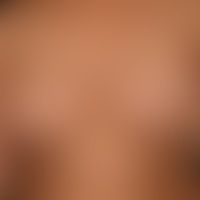
Poikiloderma (overview) L81.89
Poikiloderma: chronic graft versus host disease with bunchy, hyper- and depigmented indurated plaques.

Erythema gyratum repens L53.3
Erythema gyratum repens. chronic dynamic (changeable course for several months), linear, symptom-free, red, rough, slightly elevated linear plaques due to confluence and peripheral growth, which convey a grained overall aspect.
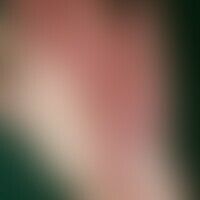
Ilven Q82.5
Cutaneous mosaic dermatosis: In a 7-year-old girl erythematosquamous, hyperkeratotic papules and plaques exist in a linear and planar arrangement since birth.

Atopic dermatitis (overview) L20.-
Eczema, atopic. 18-year-old female patient with recurrent retroauricular, strongly itchy, reddish, scaly patches, plaques and rhagades for several years. Multiple immediate type sensitizations exist in case of a positive family history.

Tinea pedis moccasin type B35.30
tinea pedis "moccasin type": little inflammatory mycosis of the foot. arrows indicate the proximal extensions of the mycosis on the back of the foot. the encircled scaling is also induced by mycosis.

Psoriasis palmaris et plantaris (plaque type) L40.3
Psoriasis palmaris et plantaris (plaque type): A minus variant with affection of the acral thumb area, forming deep and painful (therapy-resistant) rhagades.
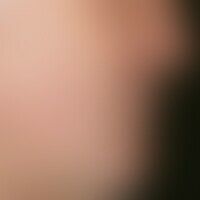
Tinea barbae B35.0
Tinea barbae. scaly, blurred, itchy erythema (incipient plaques) on the cheek and upper lip. erythema areas are sparsely interspersed with follicular papules and pustules.

